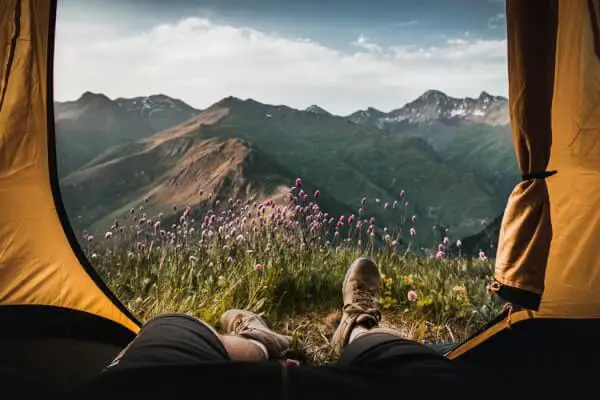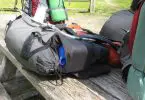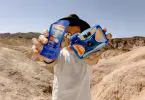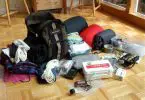I love to camp. I’ve spent most of my life outdoors, and my approach to being in the wilderness has evolved over time.
I’m not opposed to spending a weekend in the woods with twenty friends. S’mores over the campfire. Huge community meals. Horseshoes, maybe. But more and more I find myself seeking nature as a time to relax, unwind and think about life. I’ve found the best way to achieve this is by camping alone.
Any day outside is a good day. I have pitched a tent from Alaska to Mexico, and thousands of points in between. What I have learned about camping is the better prepared you are, the more enjoyable the trip.
I’m not talking about just walking into an outdoor store and throwing a ton of money at the problem. I mean having a comprehensive handbook to follow, a master plan for maximum success. To that end, I have created this how-to guide to camping by yourself.
Choosing a Destination
The first step is deciding where you are going. Maybe there is a small lake you just know will be teeming with rainbow trout. A snow covered peak in the distance that you have a yearning to climb. Or you saw a friend’s photo of a meadow, still and perfect, and you always wanted to see it for yourself. So many choices. How do you narrow it down?
A great location will provide at least one of the four basics of survival: fire, water, shelter, and food. I prefer sites near water. Bodies of water are well marked on maps and serve as a stable navigation aid if one becomes lost or disoriented. The scenery near lakes and streams is beautiful, rife with wildlife and vegetation. And, depending on how long you are staying and your personal preference, bathing becomes much easier. Of course, no one is around to smell you, so that is a plus.
See also: Best Hikes in Arizona: Hiking Locations You Can’t Afford to Miss
What if you live in the desert like I currently do? No need to panic. Choose a spot according to your personal tastes; we will address the lack of naturally occurring resources shortly.
Research the Site
Don’t skip this part. This step is what makes or breaks your trip. You want to know as much as possible before creating a packing list. An hour of Google can make you an expert in anything.
Find out the average temperature and precipitation in the area you chose. What fire restrictions are in place? Is there a ranger station nearby? What kind of predators will be sharing the woods with you? What are these predators eating (You might want/need to eat some too)?
The key is to have a clear idea of the conditions you will be facing at the time of year you will be out. For example, I once planned a trip and decided to sleep in the open. I wanted to try a new hearth-style campfire for reflective heat. No tent. No tarp. Just me under the bright desert stars. It was a great decision until the rain came. The rain predicted on all the weather services that I had not checked. Have you ever seen a monsoon and the resultant flash floods? What a miserable night. Never again. Now I plan.
The most important piece of information your research should discover is a map. A good map, hopefully topographical. And print it out. I don’t go anywhere off-road without one. Phones are great but batteries die, and signals are unreliable. A printed map is always there. Get one. Laminate it and put it in a dry bag. Trust me.
By the end of this research, you should have a pretty clear idea of what kind of clothing you will need, what type of shelter, the availability of water and fuel for your fire (if a fire is even allowed), and the general layout of the area you have chosen. Now is the time to decide the length of your trip. Simply check out our useful review of the best hiking apps to help you in your trip.
Be Honest With Yourself
Solo camping means just that. You, and only you, will be outdoors facing whatever mother nature throws at you. So be realistic. Start small. Challenge yourself in incrementally larger ways. Ways that will not end the trip if you fail. This should be an enjoyable experience, and you have a vested interest in succeeding. Mainly, going home intact.
If you do not have much experience, don’t plan a five-day trip to Zion with a ten-pound pack limit. Don’t. I’ve seen it done and it is not pretty. Those are the guys on the news coming home in a helicopter basket. I volunteer with my local search and rescue. It happens. Rule of thumb says your experience level should dictate how far from your vehicle to sleep. There is no shame in setting up a tent next to your pickup or even sleeping in the bed. It is entirely up to you; there is nothing to prove.
However, if you have the experience and want something a little more challenging, plan a hike. Give yourself reasonable daily mileage goals and choose potential stopping points for each night. Mark it all on your map. Then make a copy of the map and give it to someone you trust. Someone who will come looking for you if you don’t call in at the end by a prescribed time.
Always Create A Pack List and Use It!
Now that you have decided where to go, what it is going to be like when you get there and how long you are going to stay, it is time to figure out what to bring. If you are staying next to your vehicle, this becomes easy. If you are the adventurous sort, like me, and you will be walking around a three-day loop, your choices become more important. So, we are going to create a pack list. See our article on the best ultralight backpacking list to find out more.
This list will be everything that you need to bring. It is created as you carefully plan your trip. Some items are always on the list, no matter the type of trip. Some items are added or subtracted, based on the particular outing you are planning. How do we decide what makes our list? It is best to start with essentials for survival and then edit if you have too much gear to carry.
How Much Gear is Too Much?
This depends on you. Again, experience plays a role in deciding what is critical and what is only a luxury. I typically carry whatever I bring so I tend to travel light. If you are car camping, you can fit a lot more, using your vehicle like a supermarket throughout the trip. No matter your situation it is best to prioritize. Here is a list of basic needs to make sure you don’t miss anything:
- Shelter
- Clothing
- Fire Making Plan(s)
- Communications
- Emergency Items
- Basic Tools
- Food
- Water
Choose a Shelter
I have a friend who sleeps in a tarp and a wool blanket. He can configure these two items in a variety of ways and uses this set up exclusively when he is outdoors. Plus, it is cheap. Another friend only sleeps in hammocks.
Personally, I have a variety of tents, from three room cabins to one-man bivy sacks. I choose whichever shelter fits the trip. Usually, if it’s just me, a bivy sack, decent sleeping bag, and a rain fly are more than adequate.
The point is, use shelter which provides protection from the elements you expect and is portable enough for your needs. For tips on how to pitch a tent, check out our earlier article to find out. If you have room, consider a tarp for under your tent or a sleeping pad if the hard ground bothers your back. Once you decide, write it down as the first entry on your packing list.
What Clothes to Bring
Plan your clothing in layers with the assumption it is going to rain and be 10 degrees colder than the weatherman promised. I prefer a mixture of clothing that performs well when wet (wool sweaters are incredible) and things that dry quickly. If hiking, extra socks can help prevent blisters.
Donning a clean t-shirt can make yesterday’s clothes feel as if they all just came out of the laundry. So bring a new t-shirt for each day. They are light and don’t take up much space. Once you decide on your clothing, write it all down on your packing list.
Have Two Fire Making Plans
I was taught at an early age always to have two ways to make fire. This advice has never steered me wrong, so I am passing it on to you. An Altoids tin filled with waterproof matches and a lighter is my constant companion. As is a Ferro rod, kept on my person. For a simple guide on how to start a campfire, check out our article for more information.
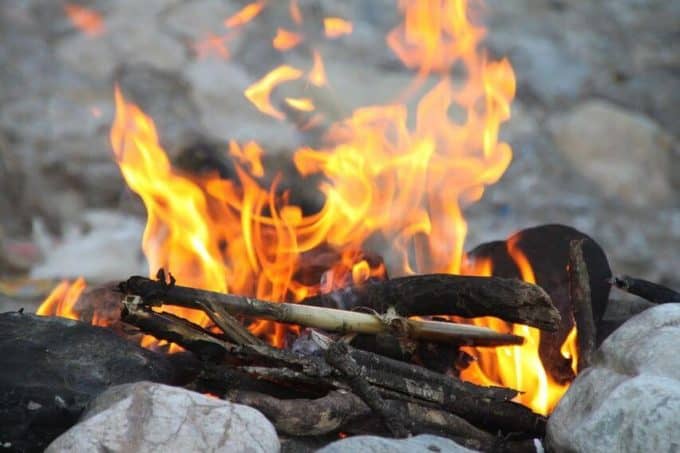
I make friction fires in various ways, but I don’t count this as a fire making plan. Too unreliable and dependent on the weather. It is important that whatever plan for fire you have is proven to work. By you. Write the plan and materials needed on your pack list.
Communication is Key
Bring your phone, but the odds are you will run out of power if away from your vehicle. I once made a solar charger, but the first time I used it my phone had no signal. So communication is really about having basic tools for emergency communication.
I carry a metal signal mirror. I also carry at least two brightly colored articles of clothing. One to wear and one to rip into strips and tie to the highest point I can reach, or wave at the end of a long stick. Smoke and fire are your best bet for communicating distress. If you don’t know how to make a fire that produces heavy smoke, read up on the technique. It could save your life. Once you decide on your tools, add them to the list.
Emergency Items: Don’t Leave Home Without Them
I am a trained EMT, so I have a very clear idea of what is useful in case I need emergency medical attention. Over time I have compiled a small first aid kit that enjoys its own pocket in my pack. Has for years. It is a simple kit but contains everything I think I will need. I carry band-aids in assorted sizes, a roll of gauze, gauze patches, medical tape, and a disinfectant / antibacterial spray.
I was given a military tourniquet years ago, so I threw that in for good measure. I have seen far more elaborate set ups, but this is what I am comfortable carrying for myself. Think about your first aid skill level and assemble your kit. There is no reason to bring something you do not know how to use. Then put it on the list.
GPS devices are great to have. But they are expensive. I carry one with an extra set of batteries. I also carry a compass and my topographical map. At the very least, the map goes on your list, but I recommend all three.
Basic Tools You Will Need
Everyone should have a great knife. A knife they trust. If you don’t, get one. Now. It doesn’t have to be expensive, but it needs to be sharp. Lately, I have been carrying a traditional K-Bar on my hip and a small utility blade on a cord around my neck.
I have yet to find a task the combination of these two blades can’t handle and they didn’t set me back an arm and a leg. I possess a custom knife, handcrafted and set in beautiful hardwood. It lives on a shelf in my office, too expensive to lose in the bush.
Hatchets save you time when gathering firewood or building structures. Mine is light, durable and sharp. In a pinch, I can throw it accurately. Make sure you get a sheath. That goes for all of your cutting tools. There is nothing worse than falling on your blade and cutting the trip short.
Are you cooking over an open fire or are you using a stove? Now is the time to decide. If using a stove how many fuel cells will you need? I have a simple cooking kit with a steel pot for boiling water and a pan. I carry a steel spoon and some bio-degradable detergent. Simple, but efficient. What you need mostly depends on the menu you are planning and how much you want to carry. Dutch ovens are great, but have you ever strapped one to your back for five days?
Cordage is the most versatile tool you will bring. I carry paracord. At least 100 feet. It is light. It is strong. And it is durable. I also wear a belt fashioned of the stuff, and my watch band and shoelaces are, you guessed it, made of paracord. Overkill? I don’t know. I just figure these are things I am taking with me regardless so they might as well have a dual purpose.
Food: Plan a Menu for the Entire Trip
Your menu can be as fancy or plain as you want. It is up to you. I plan on breakfast, lunch, dinner, and snacks for each day. For me, a good day’s consumption is around 2000 calories. Less than that and I get a little hungry. And no one wants to be hungry.
If you are near your vehicle, you can go all out, several ice chests filled with steak and chicken, a three burner stove with a full propane tank, the sky is the limit. If you are hiking, the options are more limited. I prefer freeze dried foods and breakfasts of oatmeal and powdered eggs. I never assume I will hunt, gather or forage my food. That will not work. And, it is not safe. Plan each day. Make a menu, make a shopping list, and you will be fine.
How Much Water Will I Need Each Day
Great question! I guarantee it is more than you think. Water is the great limiting factor when planning excursions. Regardless of where I am camping, I carry ten gallons in my vehicle. If I run out on the trail, at least I know where a supply lies waiting.
Men require around three liters per day while women need two. That is consumption. Now figure in cooking, washing dishes and bathing. The amount can easily double. With a car, this is not a problem. So long as you bring enough. This is not the time to be stingy. Running out of water will end your trip!
For us backpackers, a different solution is necessary. No one is carrying fifteen liters of water around. No one. Luckily, a variety of filters exists to solve this exact problem. I own several and have never had a problem, so long as a water supply exists in the area.
As a primary source, I boil water every day, first thing in the morning. I hydrate from this supply and then boil another liter for the trail. I start a fire and put the kettle on to boil as soon as I make camp for the evening and, voila! I have my three liters.
Final Thoughts
Congratulations! You are ready to go at it alone. You have carefully chosen a destination, length of trip and the style of camping you are most comfortable attempting.
You have planned your trip based on what is critical for survival and created a comprehensive pack list, so nothing essential is left behind. You have devised a menu for each day so you can enjoy the great outdoors on a full stomach and you know how much water to bring and how to get more if you need. The only thing left to do is get out there.
Featured Image Source: https://unsplash.com/photos/re2LZOB2XvY


